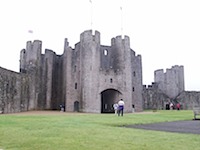If you're in Pembrokeshire, make time to visit Pembroke Castle, it's one one the best castles for understanding what they were like inside in their prime.
The castle sits up on a rocky outcrop, occupying a strategic position between two tidal inlets - no doubt why the founder of the first castle on the site, Earl Roger of Montgomery, chose to build his castle in this position in 1093. Today, as you explore its many walls, towers and passages, you'll quickly see why its position was so important.
We went on a guided tour with Sylvia Bevan; if she is there when you visit, I strongly advise you to join her. She has a wonderful way of bringing the castle's history to life and kept the children entranced with her tales of boiling sand.
One of the beauties of Pembroke is that you're allowed to go pretty much anywhere and explore the whole castle. Much of it is intact, so it makes it very easy to understand how it worked. Although it was heavily restored in the twentieth century, it doesn't detract at all, in fact it just makes it even more accessible.
The castle has connections with many famous people from the past. It was the stronghold of that formidable knight of the twelfth century, William Marshal. It was William who had much of the castle built, including the massive Keep, transforming it into the great stone fortress it is today. If you don't have a problem with vertigo, you must climb to the top of the Keep - the view is amazing.
In 1400 the Constable of the Castle, Francis A Court avoided a siege by coming to terms with Owain Glyndwr. Then later in the same century a young widow, Lady Margaret Beaufort, gave birth to her son in the castle on the 28th January 1457. Her child was Henry Tudor, the first Tudor King of England, Henry VII
During the Civil War, Pembroke was a Parliamentary stronghold until just before the war ended, it changed sides. As a result, Oliver Cromwell ordered the destruction of the castle. Fortunately he didn't do too good a job.
When you've explored all over the castle, go down into what they call the Wogan. It's a natural cave under the building, where if you look very carefully, you might just see a dragon.








